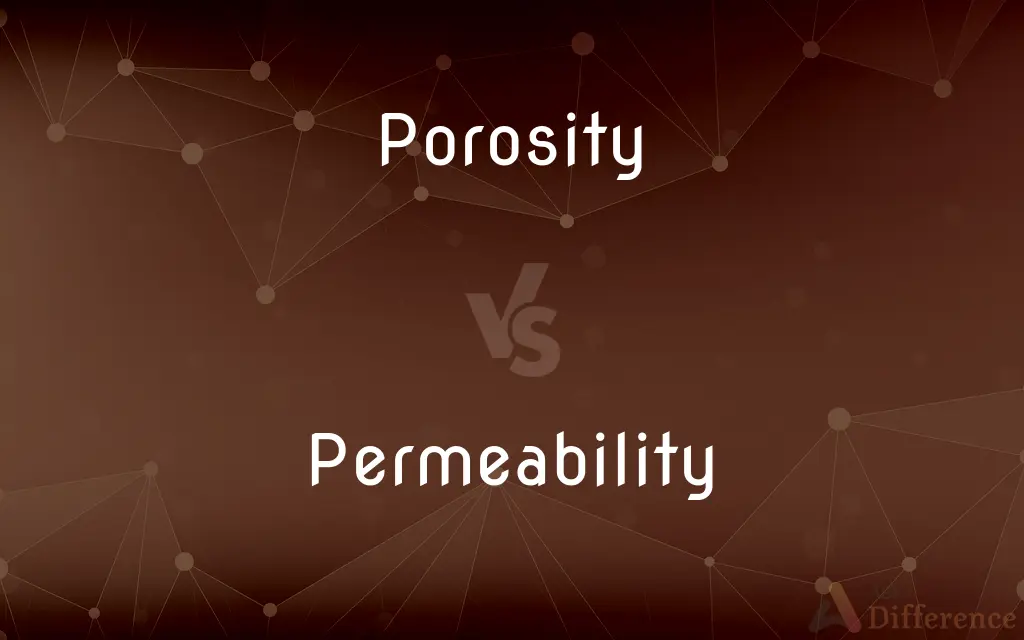Porosity vs. Permeability — What's the Difference?
By Tayyaba Rehman — Updated on September 21, 2023
Porosity refers to the volume of void spaces in a material, while permeability measures how easily fluids move through those spaces.

Difference Between Porosity and Permeability
Table of Contents
ADVERTISEMENT
Key Differences
Porosity is the measure of the void or pore spaces in a material, often expressed as a percentage of the material's total volume. It indicates how much fluid, like water or oil, a rock or soil can hold. Permeability, on the other hand, describes the ease with which fluids can flow through those pore spaces.
While porosity gives an idea about the storage capacity of rocks or soils, permeability is about their transmitting ability. High porosity doesn't always equate to high permeability. Some materials can have many pore spaces (high porosity) but might not allow fluids to move through them easily if those spaces aren't interconnected.
The tools used to measure both properties are different. Porosity is often determined using core samples in labs, where the volume of void spaces is measured relative to the total volume. Permeability is typically gauged using permeameters, which measure the rate at which fluids flow under applied pressure.
In the oil industry, understanding both porosity and permeability is crucial. Reservoir rocks with good porosity can store significant amounts of oil or gas. However, for extraction to be efficient, the permeability should also be high, ensuring the fluids can flow to the wellbore.
Porosity and permeability are critical concepts in various fields, not just oil and gas. For instance, in civil engineering, the porosity and permeability of soils can influence construction decisions, water flow, and foundation stability.
ADVERTISEMENT
Comparison Chart
Definition
Measure of void or pore spaces in a material
Ease with which fluids can flow through pore spaces
Indicates
Storage capacity
Transmitting ability
Measurement
Percentage of total volume
Rate of fluid flow under pressure
Dependence
Independent of fluid flow
Directly related to fluid flow
Application
Used in assessing storage potential of rocks or soils
Used in determining the ability to extract or move fluid
Compare with Definitions
Porosity
The fraction of void space in a rock or soil.
The sponge's porosity allows it to hold a large amount of water.
Permeability
The quality of a material to allow fluids to pass through it.
The permeability of the membrane allows selective passage of molecules.
Porosity
A quality of having many small holes or pores.
The porosity of the ceramic allows it to absorb moisture.
Permeability
A measure of how easily fluid can flow through a substance.
Sand has a higher permeability than clay, letting water flow more freely.
Porosity
The measure of a material's ability to hold fluids.
The porosity of the reservoir rock determines its oil storage capacity.
Permeability
An attribute related to the connectivity of pore spaces.
Despite its porosity, the material's low permeability made it unsuitable for filtration.
Porosity
The percentage of pore volume in a given volume of material.
The soil's porosity was tested to ensure it could support plant growth.
Permeability
The ability to convey liquid or gas.
The soil's permeability affects the rate of groundwater movement.
Porosity
A property indicating the volume of empty spaces in a solid.
Due to its high porosity, pumice can float on water.
Permeability
The capacity of a porous rock to transmit fluids.
The rock's permeability was assessed before drilling for oil.
Porosity
Porosity or void fraction is a measure of the void (i.e. "empty") spaces in a material, and is a fraction of the volume of voids over the total volume, between 0 and 1, or as a percentage between 0% and 100%.
Permeability
The property or condition of being permeable.
Porosity
The state or property of being porous.
Permeability
The rate of flow of a liquid or gas through a porous material.
Porosity
A structure or part that is porous.
Permeability
The property of being permeable.
Porosity
The ratio of the volume of all the pores in a material to the volume of the whole.
Permeability
The rate of flow of a fluid through a porous material.
Porosity
(uncountable) The state of being porous
Permeability
(geology) A measure of the ability of a rock to transmit fluids (such as oil or water).
Porosity
(countable) A measure of how porous a material is; the ratio of the volume of pores to the total volume
Permeability
(physics) A quantitative measure of the degree of magnetization of a material in the presence of an applied magnetic field (measured in newtons per ampere squared in SI units).
Porosity
The quality or state of being porous; - opposed to density.
Permeability
The quality or state of being permeable.
Porosity
The property of being porous; being able to absorb fluids
Permeability
The property of something that can be pervaded by a liquid (as by osmosis or diffusion)
Common Curiosities
Why is permeability crucial in the oil industry?
It determines how efficiently oil or gas can be extracted from reservoir rocks.
Does high porosity always mean a material will absorb more fluid?
Not necessarily. While it may store more fluid, the fluid's movement depends on permeability.
Are porosity and permeability the same?
No, porosity measures void spaces, while permeability gauges fluid flow through those spaces.
Can a material have high porosity but low permeability?
Yes, if the pore spaces aren't interconnected, a material can store fluid but not transmit it easily.
How is porosity measured?
It's often measured as a percentage, comparing the volume of voids to the total volume.
Share Your Discovery

Previous Comparison
Physician vs. Surgeon
Next Comparison
Tenosynovitis vs. TendonitisAuthor Spotlight
Written by
Tayyaba RehmanTayyaba Rehman is a distinguished writer, currently serving as a primary contributor to askdifference.com. As a researcher in semantics and etymology, Tayyaba's passion for the complexity of languages and their distinctions has found a perfect home on the platform. Tayyaba delves into the intricacies of language, distinguishing between commonly confused words and phrases, thereby providing clarity for readers worldwide.














































